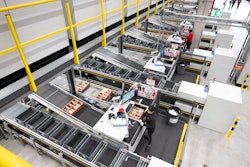
Warehouse management systems (WMS) are an imperative tool for companies aiming to increase supply chain efficiency and visibility to maintain a competitive edge. Using real-time tracking to monitor goods from arrival to departure allows for optimized control over inventory, allocation of resources and overall productivity. As businesses scale and the industry naturally evolves, taking advantage of WMS technology is now a critical part of warehousing success by reducing discrepancies of mismanagement and theft with data-driven insight.
Key advantages of a WMS
A well-performed implementation of a WMS provides tangible value and warehousing improvements, from cost reduction to clearer inventory visibility.
Strategic benefits of a WMS include:
· Increased operational efficiency: A WMS provides automation for several routine processes such as inbound and outbound order fulfillment. Additionally, integration with enterprise resource planning (ERP) and transportation management systems (TMS) expedites shipments and reduces the need for manual oversight.
· Optimized inventory turnover: For shippers of perishable or time-sensitive goods, a WMS ensures that high-priority stock ships first to reduce losses and maximize return on investment. Automated cycle counting can add an additional layer of accuracy for your inventory.
· Real-time status updates: Many WMS contain advanced tracking features like bar-coding and radio-frequency identification (RFID) to provide operations with real-time access to inventory status across your supply chain. Having transparency to this degree allows management to make informed decisions on stock levels and market forecasting.
· Workplace optimization: Using intelligent labor management tools to delegate tasks based on skill level and demand can improve operational efficiency with a reduction in obstructions for higher productivity and employee satisfaction.
· Better brand reliability: A WMS provides increased accuracy for shipments, faster fulfillment times and a reduction in order discrepancies, which enhances brand reputation within the industry and leads to higher rates of customer retention.
Types of WMS systems
When selecting a WMS, there are three primary variations of deployment models, each catered towards different operational needs and objectives.
Standalone WMS: These internally maintained systems offer the most customization and control. However, any updates or maintenance needed to keep up with scalability will require a significant investment in infrastructure and personnel.
Cloud-based WMS: Offered as a software-as-a-service (SaaS), this model allows for swift deployment, lower investment costs and increased scalability. The provider handles all updates and patches to reduce the strain on personnel while maintaining compliance with the latest industry standards.
ERP-integrated WMS: This model integrates with an organization’s established ERP and supply chain management systems, enhancing visibility across departments with real-time data synchronization and informed decision-making.
Leveraging technology and analytics for smarter warehousing
Organizations are investing more in emerging warehouse technologies such as automation and analytics to maintain a competitive advantage. Utilizing cutting-edge innovations and recorded metrics improves operating efficiency and resilience against market fluctuations.
People utilize warehouses that don't have any metrics, but they expect them to get better and run their business as efficiently as possible. You need the metrics to say, this is what we did yesterday, but how can we be a little bit better today? And how could we be a bit better the next day and the day after?
Emerging trends shaping WMS adoption
With the increasing digitization of supply chains, several technological advancements are shaping the future of warehouse management:
Artificial intelligence and machine learning: AI-backed analytics ensure optimal inventory levels with minimized disruptions through demand forecasting, planning and resource allocation.
Automation and robotics: Automation and robotics streamline order fulfillment while reducing dependencies on manual labor and boosting operational speed. New technologies like pallet dimensioners and pick and place robots have already revolutionized the industry by increasing warehouse accuracy and efficiency.
Challenges in WMS implementation
While there are many advantages, adopting a WMS also comes with several considerations:
Capital investment: Regardless of the WMS deployed, implementation requires a significant initial investment. In the long term, this can be recuperated through cost savings and improved efficiency.
System integration: Ensuring your WMS can seamlessly combine with existing ERP and supply chain platforms is vital to maximizing warehouse efficiency and return on investment.
Change management and workforce adaptation: Employees need training to properly leverage a newly implemented or updated WMS. Without a stringent onboarding process or continuous training, user adoption rates suffer from resistance to change. Find a warehouse that focuses on their people first and leverages technology second.
With the level of innovation in today’s developing market, WMS implementation is no longer optional—it is a crucial tool for organizations looking for scalable solutions and supply chain resilience. Investing in an advanced WMS not only increases operational efficiency but also signifies a strategic vision for the future.
Investing in automation, AI and integrated technologies are at the heart of industry innovation. Adopting these methods allows businesses to maintain a competitive advantage in an evolving industry and is crucial to navigating shifts in market demands, fortifying customer relationships and sustaining profitability.




















